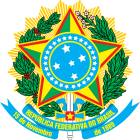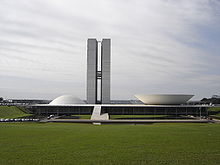- National Congress of Brazil
-
Brazil 
This article is part of the series:
Politics and government of
BrazilExecutiveLegislativeJudiciaryGeneral
The National Congress of Brazil (Portuguese: Congresso Nacional do Brasil) is the legislative body of Brazil's federal government.
Unlike regional legislative bodies – Legislative Assemblies and City Councils -, the Congress is bicameral, composed of the Federal Senate (the upper house) and the Chamber of Deputies (the lower house).
The Senate represents the 26 states and the Federal District. Each State and the Federal District has a representation of three Senators, who are elected by popular ballot for a term of eight years. Every four years, renewal of either one third or two-thirds of the Senate (and of the delegations of the States and the Federal District) takes place. When one seat is up for election in each State, each voter casts one vote for the Senate; when two seats are up for election, each voter casts two votes, and the voter cannot give his two votes for the same candidate, but, in elections for the renewal of two-thirds of the Senate, each party can present two candidates for election. The candidate in each State and the Federal District (or the first two candidates, when two thirds of the seats are up for election) who achieve the greatest plurality of votes are elected.
The Chamber of Deputies represents the people of each state, and its members are elected for a four year term by a proportional representation. Unlike the Senate, the whole of the Chamber of Deputies is renewed every four years.
The Congress meets annually in its Brasília seat from 2 February to 27 July and from 1 August to 22 December.
Until recently, it was common for politicians to switch parties, and the proportion of congressional seats held by each party would often change. However, a decision of the Supremo Tribunal Federal has ruled that the seats belong to the parties and not to the politicians, and that one can only change parties and retain his seat in a very limited set of cases, so that now politicians who abandon the party for which they were elected face the loss of their Congressional seat.
Each house of the Brazilian Congress elects its President and the other members of its directing board from among its members.
The President of the Senate (currently Senator José Sarney) is ex officio the President of the National Congress, and in that capacity summons and presides over joint sessions, as well as over the joint services of both Houses.
However, the President of the Chamber (currently Marco Maia) is the third in the presidential line of succession, while the President of the Senate (and of Congress) ranks as fourth in line to the presidency of the Republic.
Contents
Houses
Federal Senate
The Federal Senate of Brazil (Portuguese: Senado Federal do Brasil) is the upper house of the National Congress of Brazil. Created by the first Constitution of the Brazilian Empire in 1824, it was inspired in United Kingdom's House of Lords, but with the Proclamation of the Republic in 1889 it became closer to the United States Senate. Currently, the Senate comprises 81 seats. Three Senators from each of the 26 states and three Senators from the Federal District are elected on a majority basis to serve eight-year terms. Elections are staggered so that two-thirds of the upper house is up for election at one time and the remaining one-third four years later. The current president of the Brazilian Senate is José Sarney, from the Brazilian Democratic Movement Party of Amapá. He was elected in early 2009 for a two-year term.
Chamber of Deputies
The Chamber of Deputies is composed of 513 federal deputies, who are elected by a proportional representation of votes to serve a four-year term. Seats are allotted proportionally according to each state's population, with each state eligible for a minimum of eight seats (least populous) and a maximum of 70 seats (most populous).
The building
In early 1900s, the Brazilian National Congress happened to be in separate buildings. The Senate, for instance, was located near Railway Central Station, beside the Republica's Square, at Moncorvo Filho Street, where there is today a Federal University of Rio de Janeiro students' center. The Federal Chamber of Deputies was located at Misericórdia Street, where it would be built later the State of Rio de Janeiro's local Chamber of Deputies. From the 1930s to early 1960s, the Senate occupied the Monroe Palace, which was demolished in the 1970s to allow the construction of the subway Cinelândia station. The Federal Chamber of Deputies moved to Brasília in early 1960s as well, but temporarily occupied for a couple of years a building near the Municipal Theater.
Since the 1960s, the National Congress has been located in Brasília. As with most of the city's government buildings, the National Congress building was designed by Oscar Niemeyer in the modern Brazilian style.
The semi-sphere on the left is the seat of the Senate, and the semi-sphere on the right is the seat of the Chamber of the Deputies. Between them are two vertical office towers. The Congress also occupies other surrounding office buildings, some of them interconnected by a tunnel.
The building is located in the middle of the Monumental Axis, main street of Brasília. In front of it there is a large lawn where demonstrations take place. At the back of it, is the Praça dos Três Poderes, where lies the Palácio do Planalto and the Supremo Tribunal Federal.
On December 6, 2007, the Institute of Historic and Artistic National Heritage (Portuguese: Instituto do Patrimônio Histórico e Artístico Nacional) decided to declare the building of the National Congress a historical heritage of the Brazilian people. The building is also among the UNESCO World Heritage Sites, as part of Brasília's original urban buildings, since 1987.
In 2010, 22 out of the country's 27 political parties were able to elect at least one representative in the Chamber, while fifteen of them were able to elect at least one Senator. In both houses the coalition that supported
Summary of the 3 October 2010 National Congress election results Parties Chamber Senate Votes % of votes Seats % of seats +/– Votes % of votes Elected seats Total seats % of seats +/– Worker's Party (Partido dos Trabalhadores, PT) 16,289,199 16.9 88 17.1 +5 39,410,141 23.1 11 15 17.3 +7 Brazilian Democratic Movement Party (Partido do Movimento Democrático Brasileiro, PMDB) 12,537,252 13.0 79 15.3 −10 23,998,949 14.1 16 19 24.6 +3 Republic Party (Partido da República, PR) 7,311,655 7.6 41 7.9 +16 4,649,024 2.7 3 4 4.9 — Brazilian Socialist Party (Partido Socialista Brasileiro, PSB) 6,851,053 7.1 34 6.6 +7 6,129,463 3.6 3 3 3.7 — Democratic Labour Party (Partido Democrático Trabalhista, PDT) 4,854,602 5.0 28 5.4 +4 2,431,940 1.4 2 4 4.9 −2 Social Christian Party (Partido Social Cristão, PSC) 3,072,546 3.2 17 3.3 +8 1,247,157 0.7 1 1 1.2 — Communist Party of Brazil (Partido Comunista do Brasil, PCdoB) 2,748,290 2.8 15 2.9 +2 12,561,716 7.4 1 2 2.4 +1 Brazilian Republican Party (Partido Republicano Brasileiro, PRB) 1,633,500 1.7 8 1.5 +7 3,332,886 2.0 1 1 1.2 −1 Christian Labour Party (Partido Trabalhista Cristão, PTC) 595,431 0.6 1 0.1 −2 282,629 0.2 0 0 0.0 — National Labour Party (Partido Trabalhista Nacional, PTN) 182,926 0.2 0 0.0 — 6,013 0.0 0 0 0.0 — Brazilian Social Democratic Party (Partido da Social Democracia Brasileira, PSDB) 11,477,380 11.9 53 10.3 −13 30,903,736 18.1 5 11 13.5 −5 Democrats (Democratas, DEM) 7,301,171 7.6 43 8.3 −22 10,225,883 6.0 2 6 7.4 −7 Brazilian Labour Party (Partido Trabalhista Brasileiro, PTB) 4,038,239 4.2 21 4.0 −2 7,999,589 4.7 1 6 7.4 −1 Socialist People's Party (Partido Popular Socialista, PPS) 2,536,809 2.6 12 2.3 −10 6,766,517 4.0 1 1 1.2 +1 Party of National Mobilization (Partido da Mobilização Nacional, PMN) 1,086,705 1.1 4 0.7 +1 241,321 0.1 1 1 1.2 +1 Labour Party of Brazil (Partido Trabalhista do Brasil, PTdoB) 642,422 0.7 3 0.5 +2 1,480,846 0.9 0 0 0.0 Progressive Party (Partido Progressista, PP) 6,330,062 6.6 41 7.9 — 9,170,015 5.4 3 4 4.9 +3 Green Party (Partido Verde, PV) 3,710,366 3.8 15 2.9 +2 5,047,797 3.0 0 0 0.0 −1 Socialism and Freedom Party (Partido Socialismo e Liberdade, PSOL) 1,142,737 1.2 3 0.5 — 3,041,854 1.8 2 2 2.4 +1 Humanist Party of Solidarity (Partido Humanista da Solidariedade, PHS) 764,412 0.8 2 0.3 — 305,793 0.2 0 0 0.0 — Social Liberal Party (Partido Social Liberal, PSL) 499,963 0.5 1 0.1 +1 446,517 0.3 0 0 0.0 — Brazilian Labour Renewal Party (Partido Renovador Trabalhista Brasileiro, PRTB) 307,925 0.3 2 0.3 +2 74,478 0.0 0 0 0.0 — Progressive Republican Party (Partido Republicano Progressista, PRP) 307,188 0.3 2 0.3 +2 0 0.0 0 0 0.0 — Others 358,178 0.4 0 0.0 — 677,309 0.4 0 0 0.0 — Total valid votes 96,580,011 100.0 513 100.0 — 170,431,573 100.0 45 81 100.0 — Sources: Chamber, Senate Coordinates: 15°47′58.82″S 47°51′51.05″W / 15.7996722°S 47.8641806°W
See also
External links
- (Portuguese) Photos 360º of National Congress
 Brazil
BrazilHistory First inhabitants · Colonization · Empire · Old Republic · Vargas Era · Second Republic · Military rule · ContemporaryGeography Regions · States · Mesoregions · Microregions · Municipalities · Islands · Coastline · Climate · Environment · Extreme points · Protected areas · CapitalsGovernment Constitution · Federal government · President · National Congress · Foreign relations · Law · Law enforcement · MilitaryPolitics Economy Society Demographics · People · Languages · Religion · Immigration · Education · Health · Crime · Social issues · Largest cities · ApartheidCulture  Category ·
Category ·  Portal ·
Portal ·  WikiProjectCategories:
WikiProjectCategories:- National legislatures
- Government of Brazil
- Politics of Brazil
- Parliaments by country
- Oscar Niemeyer buildings
- Bicameral legislatures
Wikimedia Foundation. 2010.






